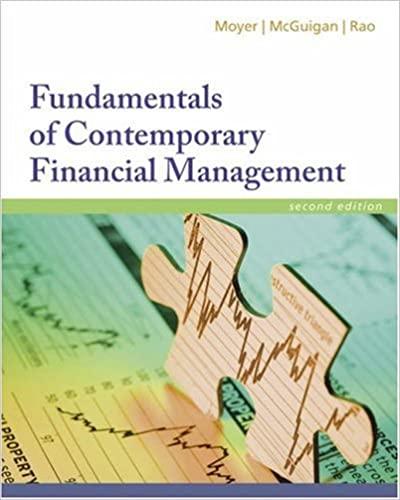Question
Weighted Average Cost of Capital Calculation We are required to assess Canadian aircraft manufacture Bombardiers future prospect by looking into its Weighted Average Cost of
Weighted Average Cost of Capital Calculation
We are required to assess Canadian aircraft manufacture Bombardiers future prospect by looking into its Weighted Average Cost of Capital (WACC). Our research tells us that:
Bombardiers Beta was 1.214 and the Market Risk Premium was 5.69 per cent. We set out to calculate the weight of equity for Bombardier based on the closing share price as of December 30, 2016. By looking at the 2016 Annual Report, we can determine the number of shares outstanding of both preferred and common shares (Table 1)

The exchange rate (Table 2) is important because the values in the Annual Report are in USD whereas the share prices are in CAD. We need to convert the USD values to CAD. The company's effective tax rate was 19.13 per cent (an average of the last 4 years). For the same day, December 31, 2016, we researched the Canadian 10-year bond yield at the Bank of Canada, (which would be necessary in calculating the cost of equity). The yield was 1.72%.

We need to incorporate the range of preferred shares and their most recent dividend payouts (Table 3) into the cost of capital calculations.

When calculating the cost of debt, we would include the company's long-term debt and only Sale and Leaseback Obligations (Table 4).

We assume 1, the LTD at December 31st 2016 are the best estimates of the market values in USD; 2, the cost of the Sale and Leaseback was 10 %; 3, For the debt marked with a dash, the market value is 0 (i.e. it has been paid off).
Finally, we find the bond prices for all of Bombardier's long term debt (Table 5). The bond prices are necessary for the computation of the YTM of each bond with the exception of the "Other" entry, the cost of which for December 31st, 2016 was explained in a footnote in the LTD Table. One issue is how to handle fractional years for bond maturities. For simplicity, we round the round the number of periods down when computing the YTM of each bond. (E.g., for the April 2019 bond he assumed it has 4 semi-annual periods to maturity).

Requirement: using the given information, calculate Bombardier's WACC.
Table 1 Preferred shares The preferred shares authorized were as follows, as at December 31, 2016, and 2015 and January 1, 2015: Authorized for the specific series Series 2 cumulative Redeemable Preferred Shares 12,000,000 Series 3 Cumulative Redeemable Preferred Shares 12,000,000 Series 4 Cumulative Redeemable Preferred Shares 9,400,000 Share Price: The preferred shares issued and fully paid were as follows, as at: December 31, 2016 Series 2 cumulative Redeemable Preferred Shares 9,692,521 Series 3 Cumulative Redeemable Preferred Shares 2,307,479 Series 4 Cumulative Redeemable preferred Shares 9,400,000 December 31, 2015 January 1, 2015 Date Open High Low Close 9,692,521 9,692,521 12/30/168.87 8.878.70 8.85 2,307,479 2,307,479 12/30/16 8.88 8.89 8.88 8.89 9,400,000 12/30/15 17.49 17.50 17.37 17.49 Common shares All common shares are without nominal or par value. Class A Shares (multiple voting) December 31, 2016 December 31, 2015 313,900,550 Issued and fully paid Balance at beginning of year Converted to Class B Balance at end of year Authorized 313,900,550 3,592,000,000 314,273,255 (372,705) 313,900,550 2,742,000,000 Date Open High Low Close 12/30/16 2.35 2.36 2.33 2.33 Class B Shares (subordinate voting) December 31, 2016 December 31, 2015 Issued and fully paid Balance at beginning of year Issuance of shares Converted from Class A 1,932,511,397 164,466 1,444,132,126 488,006,566 372,705 1,932,511,397 1,932,675,863 Held in trust under the PSU and RSU plans Balance at beginning of year Purchased Date Open High Low Close 12/30/16 2.182.182.162.16 (26,194,908) (27,338,210) (53,533,118) 1,879,142,745 3,592,000,000 (18,736,908) (7,458,000) (26,194,908) 1,906,316,489 2,742,000,000 Balance at end of year Authorized Table 1 Preferred shares The preferred shares authorized were as follows, as at December 31, 2016, and 2015 and January 1, 2015: Authorized for the specific series Series 2 cumulative Redeemable Preferred Shares 12,000,000 Series 3 Cumulative Redeemable Preferred Shares 12,000,000 Series 4 Cumulative Redeemable Preferred Shares 9,400,000 Share Price: The preferred shares issued and fully paid were as follows, as at: December 31, 2016 Series 2 cumulative Redeemable Preferred Shares 9,692,521 Series 3 Cumulative Redeemable Preferred Shares 2,307,479 Series 4 Cumulative Redeemable preferred Shares 9,400,000 December 31, 2015 January 1, 2015 Date Open High Low Close 9,692,521 9,692,521 12/30/168.87 8.878.70 8.85 2,307,479 2,307,479 12/30/16 8.88 8.89 8.88 8.89 9,400,000 12/30/15 17.49 17.50 17.37 17.49 Common shares All common shares are without nominal or par value. Class A Shares (multiple voting) December 31, 2016 December 31, 2015 313,900,550 Issued and fully paid Balance at beginning of year Converted to Class B Balance at end of year Authorized 313,900,550 3,592,000,000 314,273,255 (372,705) 313,900,550 2,742,000,000 Date Open High Low Close 12/30/16 2.35 2.36 2.33 2.33 Class B Shares (subordinate voting) December 31, 2016 December 31, 2015 Issued and fully paid Balance at beginning of year Issuance of shares Converted from Class A 1,932,511,397 164,466 1,444,132,126 488,006,566 372,705 1,932,511,397 1,932,675,863 Held in trust under the PSU and RSU plans Balance at beginning of year Purchased Date Open High Low Close 12/30/16 2.182.182.162.16 (26,194,908) (27,338,210) (53,533,118) 1,879,142,745 3,592,000,000 (18,736,908) (7,458,000) (26,194,908) 1,906,316,489 2,742,000,000 Balance at end of year Authorized
Step by Step Solution
There are 3 Steps involved in it
Step: 1

Get Instant Access to Expert-Tailored Solutions
See step-by-step solutions with expert insights and AI powered tools for academic success
Step: 2

Step: 3

Ace Your Homework with AI
Get the answers you need in no time with our AI-driven, step-by-step assistance
Get Started


